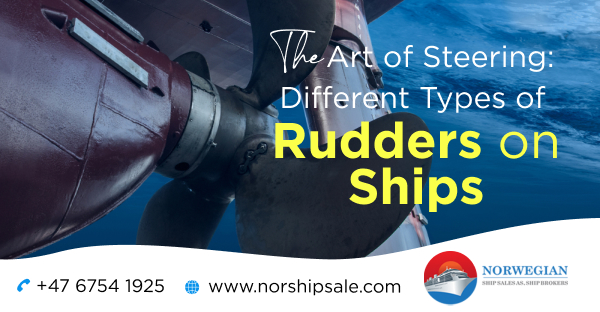The rudder is crucial in determining how a ship will move amid the vastness of the sea. The standard rudder, a seemingly simple piece of gear, is available in a variety of forms and designs, each one suitable for specific vessels and navigational requirements. In this write-up, we delve into the world of ship rudders, learning about their significance, their purposes, and the various types that keep maritime boats on course. Every shipowner or someone planning to invest in a ship must gather as much information as possible on all aspects of a ship, so aside from reading this article, it is also important to hire a ship broker company in Norway for a successful purchase.
Let’s get started.
The Role of Rudders
Let’s take a moment to understand the basics of ship steering before delving into the many types of rudders. One of the main elements of a ship’s steering system is the rudder. Its primary function is to guide the direction the ship goes through the water, and it is normally found towards the stern (rear) of the boat.
Rudders function by changing the direction of the water’s flow as the ship travels. The water’s flow is diverted by angling the rudder to the left or right, producing a lateral force that rotates the ship in the desired direction. The mobility and handling characteristics of a ship are greatly influenced by the size, shape, and design of the rudder.
For more information, take a look at the below section, or contact a top shipbroker company in Norway.

Different Types of Rudders on Ships
Now, take a look at the various types of rudders used on ships.
1. Spade Rudder
Modern ships frequently use the spade rudder style of rudder. It is immediately linked to the vessel’s hull and distinguished by the look of a blade. Spade rudders are perfect for a variety of ship types, including sailboats, yachts, and smaller vessels. They provide outstanding maneuverability and responsiveness.
2. Skeg- Mounted Rudder
Skeg-hung or mounted rudders are supported in part by the ship’s skeg, which is a vertical extension of the hull. The rudder is given more stability by this design, which makes underwater obstructions less likely to hurt it. Sailing yachts and some motorboats frequently employ skeg-hung rudders.
3. Balanced Rudder
The effort needed to control a ship is lessened by balanced rudders. They have a pivot point on the rudder stock-forward portion of the rudder blade. With this design, the water pressure on the aft portion of the blade is reduced, making it simpler to turn the rudder. Larger vessels frequently have balanced rudders because of their effectiveness and precise control.
4. Full Spade Rudder
As the name suggests, full spade rudders have a rudder blade that spans the entire length of the vessel’s hull. The efficiency and control of the rudder are maximized by this design. Larger ships, such as commercial cargo ships and cruise ships, where precise agility is crucial, frequently have full spade rudders.
5. Semi Balanced Rudder
The balanced and unbalanced rudders both had their share of issues when the steering gear system failed, which led to the development of the semi-balanced rudder. The ship’s rudders, both balanced and unbalanced, would remain stationary as it turned. A semi-balanced rudder has a balanced chord length overall, but the upper portion of the chord length is unbalanced. This is so that the balanced half will allow the least amount of torque to move the rudder, and the unbalanced part will extend the proper structural support. Thus, when the steering gear system malfunctions during a course change, the semi-balanced rudder automatically returns to the centerline. These days, this kind of rudder is typically found on ships.
6. Twin Rudders
Some ships have two rudders that are placed side by side. Twin rudders offer improved control and stability, particularly during choppy seas. They enable better handling and less drag and are frequently utilized in contemporary sailing boats and certain motor vessels.
7. Spade Rudder With Bulb
A specific kind of rudder used on ships and boats is a spade rudder with a bulb. The rudder blade’s bottom has a bulb or extension in this configuration. The bulb’s function is to improve the stability and performance of the rudder. It boosts the rudder’s effectiveness by increasing mass and surface area to the lower part of the blade, especially in rough sea conditions. Spade rudders with bulbs are a good choice for larger sailboats and racing yachts because they enhance stability and control.
8. Flap Rudder
The trailing edge of the rudder blade has an extra flap in flap rudder designs. The ship’s steering qualities can be fine-tuned by adjusting this flap. In bigger vessels, where precise control and effectiveness are crucial, flap rudders are frequently used.
Conclusion
In conclusion, ship steering is an essential component of marine engineering, and the choice of the rudder has a big impact on how manoeuvrable and controlled a ship is. Each kind of rudder—from twin to spade—serves a particular function and meets the varying demands of different kinds of vessels. If you are planning to purchase a ship, then knowing about the different rudders would help you make a successful purchase. And, for detailed information, it would be best if you consult expert ship brokers. If you are based out of Norway, you can get in touch with any top ship broker companies in Norway.

